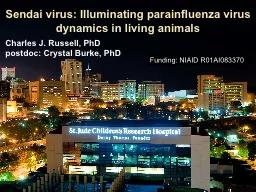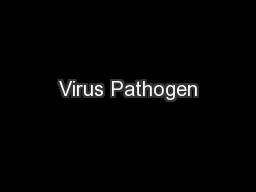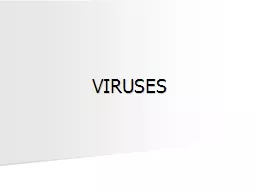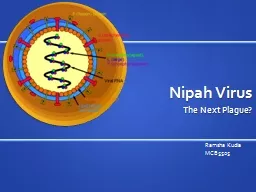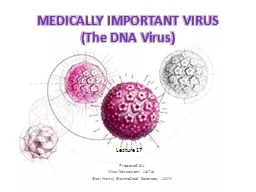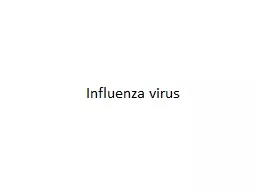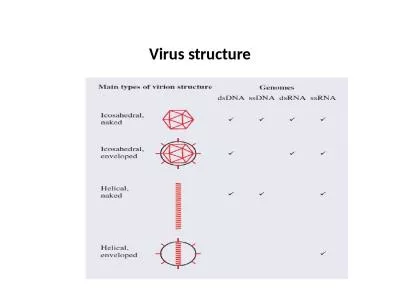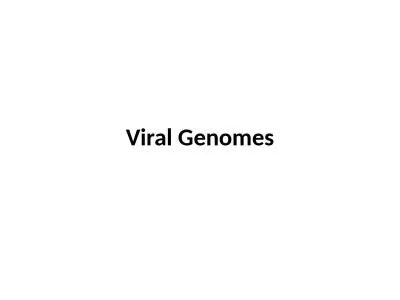PPT-What is a virus?
Author : kinohear | Published Date : 2020-08-28
Viruses They lack a cell membrane Dont have a nucleus Dont have organelles They have a variety of shapes They are too small to be seen unless you use the electron
Presentation Embed Code
Download Presentation
Download Presentation The PPT/PDF document "What is a virus?" is the property of its rightful owner. Permission is granted to download and print the materials on this website for personal, non-commercial use only, and to display it on your personal computer provided you do not modify the materials and that you retain all copyright notices contained in the materials. By downloading content from our website, you accept the terms of this agreement.
What is a virus?: Transcript
Viruses They lack a cell membrane Dont have a nucleus Dont have organelles They have a variety of shapes They are too small to be seen unless you use the electron microscope How do they multiply. 1. October 2013. Max Planck Institute Magdeburg. Options for continuous production of . cell culture-derived viral vaccines. MAX-PLANCK-INSTITUT. DYNAMIK KOMPLEXER. TECHNISCHER SYSTEME. MAGDEBURG. Frensing. The Art of Reconstruction. In order to survive, viruses must be able to do the following:. 1. Find a host cell it can replicate in. 2. Bind to that cell. 3. Enter the cell. 4. Release its genome in order to replicate. MECANISMOS DE PATOGENICIDAD Y ADAPTABILIDAD HUMANA DE CEPAS GRIPALES AVIARIAS Y PORCINAS. Dr. A. Paño. EPIDEMIOLOGIA . : ES LA CIENCIA QUE ESTUDIA LAS ENFERMEDADES TRASMISIBLES Y NO TRASMISIBLES Y LOS FACTORES QUE DETERMINAN SU FRECUENCIA Y DISTRIBUCIÓN EN LA POBLACIÓN.. Charles J. Russell, PhD. postdoc: Crystal Burke, PhD. Funding: NIAID R01AI083370. HPIV1, HPIV2, HPIV3. leading cause of pediatric hospitalization (21,000/. yr. in USA). . virtually all infected by age 5; reinfections common but usually less severe. Resource (. ViPR. ). :. an . Open Bioinformatics Database and Analysis Resource for Human Virus Pathogen . Research. Yun Zhang. 1. , Brett . Pickett. 1. , . Eva Rab. 1. , . Jyothi. . Noronha. 1. , R. Burke Squires. Viruses Are Not Cells!. There are several structural and functional differences between cells and viruses. The structural differences include:. No nucleus. No cell membrane. No organelles. The functional differences include:. Technology is Evolving. Computer’s have become smaller, faster, and more efficient. Many new helpful devices. Heavy Dependency of Technology: Y2K. Technology causes the evolution of different programs. Instructions. You may use your notes.. Write your answers in the spaces provided.. This review is due at the end of the period!. 1. What . process is . shown in . the . diagram below. ?. . Describe what is happening in each step.. The Next Plague?. Ramsha Kudia. MCB5505. Taxonomy . Family: Paramyxoviridae. Subfamily Paramyxovirinae. Genus Avulavirus . Newcastle disease virus. Genus Henipavirus . Hendravirus . Nipahvirus. Genus Morbillivirus . : . A threat . to wheat . production enhanced by warming climate . Tim . Seipel. , . Nar . B. . Ranabhat. , . Erik A. . Lehnhoff. , . Zach J. . Miller, . Fabian D. . Menalled. , . and Mary E. . Burrows. (The DNA Virus). Prepared by:. Miss . Norzawani. . Jaffar. Bsc. (. Hons. ) Biomedical Sciences, UKM. Lecture 17. Learning Outcomes. At the end of this learning session, student must be able to;. Classify the viruses. The influenza virus group consists of three enveloped RNA members of the family Orthomyxoviridae:. influenza A, B, and C. . Influenza A . viruses are further classified into hemagglutinin (H) and neuraminidase. . Outside . their host cells, viruses survive as . virus particles. , also known as . virions. . The . virion. is a . gene delivery . system; it contains the virus genome, and . its functions . are to protect the genome and to aid its . Viruses are very small – smaller than the smallest cell.. They are usually surrounded by a capsid of proteins.. For replication, viruses rely on their host cells . ie. ., the cells they infect.. Most viruses exhibit a limited host range- they typically infect only specific types of cells of one host species..
Download Document
Here is the link to download the presentation.
"What is a virus?"The content belongs to its owner. You may download and print it for personal use, without modification, and keep all copyright notices. By downloading, you agree to these terms.
Related Documents




